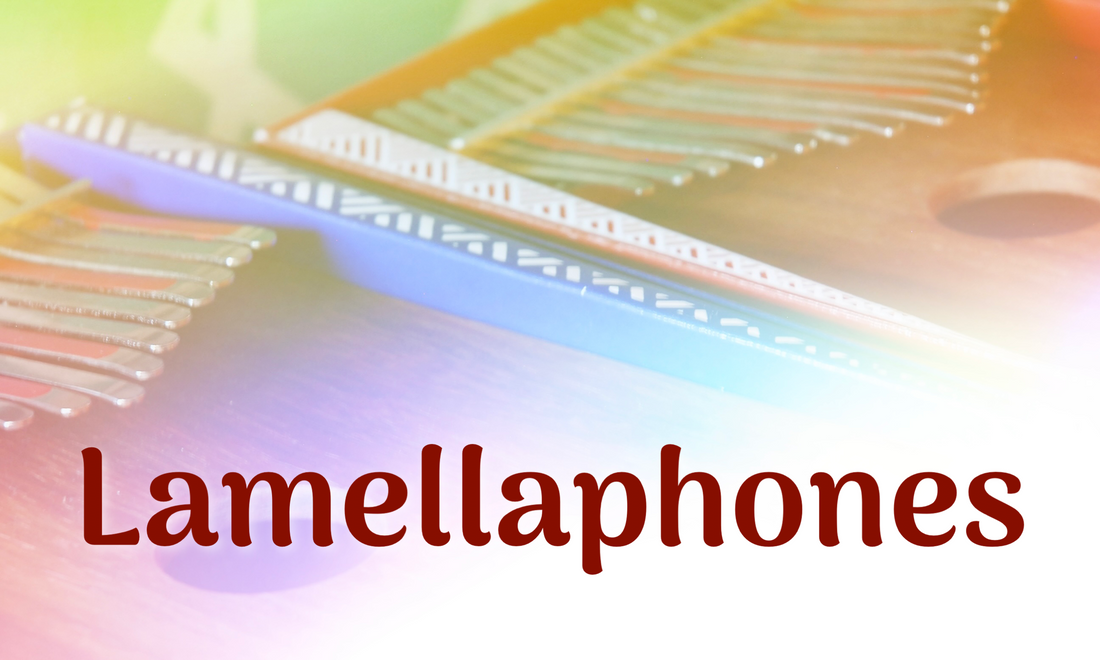The mbira – also widely referred to as kalimba or thumb piano – is a member of the idiophone and lamellaphone instrument families. As an idiophone, it falls into the category of percussion instruments that vibrate to produce a sound when struck, but the metal tines or lamellae of different sizes and shapes can create different pitches when plucked by the thumbs. Each metal tine is fixed in place at one end to a block of wood that works as a resonator, and free at the other side to be struck by a thumb or finger. Generally, mbiras include a wooden sounding board, along with somewhere between 5 and 20 metal tines.
This instrument has many names, and is said to have been invented in at least two separate places on the African continent: about 3000 years ago near present-day Cameroon, where it was made almost entirely out of wood (bamboo and gourds), and more recently about 1300 years ago in Zambezi, following the Iron Age, where it included metal lamellae. The metal tines produce brighter and louder sounds, and are far more common in modern iterations. The first European to document this style of lamellophone was Portuguese missionary Father Dos Santaos, who described a 9-note metal "ambira" in 1586. These instruments were generally played in the king's palace, indicating the cultural importance attached to this seemingly humble instrument (read more here).
The name "kalimba" was coined by ethnomusicologist Hugh Tracey, when he developed a version of the historically African instrument for use in western music during the 1950s, incorporating a diatonic scale (find out more about this here). This may seem on the surface like yet another story of a European seeking to profit off the creative endeavors of African people, re-branding an idea as his own for maximum profit. However, Hugh Tracey had a genuine interest in both understanding and documenting the traditional music of African people, from the standpoint of a person who spent his youth working on a tobacco farm in Zimbabwe. His experiences growing up in that area brought him to the discovery of a life-long fascination with African music, even while most europeans of that time were entirely disinterested in these rich cultural traditions. In 1954, Dr. Tracey founded the International Library of African Music (ILAM), one of the largest repositories of African musical history (find out more about this here). In order to fund future expeditions for musical study, Dr. Tracey founded a business known as African Musical Instruments (AMI) and included the Hugh Tracey Kalimba of his own design in this collection.
It's important to keep in mind that many forms of this lamellaphone exist, varying in appearance in accordance with the cultural traditions of specific geographic regions. For example, the likembe, sanza, and senza originate around Cameroon and Congo; the ubo can be found in Nigeria; the malawi, lukeme, and karimba are common to Uganda; and various forms of mbira were developed by the Shona people of Zimbabwe, including the matepe, nyunga nyunga, and mbira dzavadzimu (the 'big mbira of the ancestral spirits'). The African mbira has likely inspired the development of other related lamellaphones of the African diaspora, including the marimbula of the Caribbean and South America, as well as metal tongue drums.
There are some important features help to distinguish kalimbas from mbira. The kalimba, following the design of Dr. Hugh Tracey tends to have a do-re-mi western scale, and alternating left and right notes to allow for playing modern western music. Conversely, mbira typically have 3 groupings of metal keys, one on the right, and two on the left; designed to be played with both thumbs and the right index finger. Additionally, there is usually a hole on the bottom of the instrument, designed for a pinky finger to better grip the instrument. Mbira traditionally have a range of nearly 3 octaves, and are not necessarily tuned to a western musical scale (though they increasingly do, in more modern iterations). Sometimes shells, metal beads, or bottle caps are affixed to the mbira to produce a buzzing sound. A hollow gourd is often added to improve natural resonance.
The kalimba has become a popular instrument worldwide. People of all ages are drawn to playing them. These small portable instruments feel good in the hands, and the metal tines are fun to explore, producing sweet bell-like tones. Historically, these instruments have social and recreational relevance, but also a spiritual significance in connecting to one's ancestors. The instrument is believed also to have healing properties, with ceremonial function in bringing people together as a community, and to accompany song (read more on this here). Each form of kalimba and mbira comes with its own rich cultural history and set of traditions. Delving into understanding these traditions can deepen the appreciation for the music itself.
Explore our collection of kalimbas and other lamellaphones here

